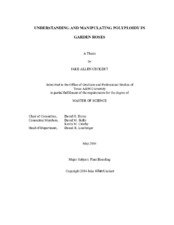| dc.description.abstract | Rose chromosome number ranges from 14 to 56 and understanding the dynamics
of rose chromosome numbers can help improve the progress made in breeding programs
and enhance the understanding of certain rose populations. An analysis of the pollen
diameter of 126 roses in a breeding collection suggested that 49 were diploid, 67 were
tetraploid, and 10 were hexaploid. An analysis of the pollen diameter combined with
pollen appearance suggested that 39 were diploid, 39 were triploid and 48 were
tetraploid. Chromosome counts determined that there were 44 diploids, 28 triploids, and
54 tetraploids. Thus pollen diameter was 86.3% accurate in identifying diploids and 74%
accurate in identifying tetraploids. Pollen diameter and appearance was 77.2% accurate
for diploids, 71.4% accurate for triploids and 66% accurate for tetraploids. A common
occurrence among the triploids was the presence of irregular and shrunken pollen grains
that were likely aneuploids leading to pollen abortion. However, some triploids showed
very few shrunken pollen grains and consistent pollen sizes which could suggest that
these individuals have better fertility relative to other triploids. Among diploid and
tetraploid plants, the frequency of 2n pollen grain production was 9% and 1.8%
respectively. A series of interploidy crosses indicated that there were small differences
in set, seed yield and seed germination in crosses done between diploids or between
tetraploids as compared to those done between either diploid or tetraploids and the
triploid ‘Homerun’. The ploidy level of the seedlings of these crosses was followed and
it was determined that the triploid plant produced viable n, 2n and 3n gametes. When the
triploid plant ‘Homerun’ was crossed with tetraploid seed parents, there was a nearly even distribution of progeny resulting from fertilization with 1n and 2n pollen grains. When ‘Homerun’ was crossed with diploid seed parents, there were more progeny resulting from 2n gametes than n gametes. The progeny of these diploid x triploid crosses also exhibited reduced fertility as seen in the high percentages of shrunken pollen grains in these individuals. | en |


